The Pentacon Six
System
by TRA
Lens Data Summary
Russian and Ukrainian
lenses for the Kiev 60
Most of these lenses were to the best of my knowledge produced by
the Arsenal factory in Kiev, Ukraine. I welcome corrections
and further information concerning sources of design and
manufacture, or news of other lenses that have been available in
the Pentacon Six / Kiev 60 mount. Most of this data is based
on published information; I have not weighed and measured all
these lenses myself.
| Lens name (1) |
Max aperture
& focal length |
Depth of field
preview
lever? (2) |
Angle
of view
degrees |
Closest
focus
m |
Filter
thread |
Dimensions
(Diameter ×
length) mm |
Weight
g (3) |
| Zodiak-8B |
f/3.5 / 30 |
No |
180 |
0.3 |
(rear) M 38 × 0.5 |
110 × 97 |
1000 |
| Mir-26B |
f/3.5 / 45 |
No |
83 |
0.5 |
M 82 × 0.75 |
86 × 96.5 |
650 |
| Mir-69B (4) |
f/3.5 / 45 |
Yes |
83 |
0.5 |
M 67 × 0.75 |
76 × 61 |
450 |
| Mir-3B (5) |
f/3.5 / 65 |
No |
66 |
0.8 (6) |
M 88 × 0.75 |
91 × 115 (7) |
620 (8) |
| Mir-38B |
f/3.5 / 65 |
No (9) |
66 |
0.5 |
M 72 × 0.75 |
78 × 88 |
550 |
| Volna-3 |
f/2.8 / 80 |
Yes |
53 |
0.6 |
M 62 × 0.75 |
76 × 57 |
340 |
| Vega-12 (10) |
f/2.8 / 90 |
No |
47 |
0.6 |
M 58 × 0.75 |
70 × 66.5 |
365 |
| Vega-28B |
f/2.8 / 120 |
Yes |
41 |
1.2 |
M 62 × 0.75 |
76 × 58 |
450 |
| Kaleinar-3B |
f/2.8 / 150 |
No |
28 |
1.8 |
M 82 × 0.75 |
88 × 99 (11) |
1100 |
| Jupiter-36B |
f/3.5 / 250 |
No |
19 |
3.5 |
M 82 × 0.75 |
85 × 180 |
1500 |
| Telear-4B (12) |
f/3.5 / 250
|
Yes
|
19
|
2.5
|
M 77 × 0.75
|
80 × 150
|
900
|
| Telear-5B |
f/5.6 / 250 |
Yes |
19 |
2.5 |
M 62 × 0.75 |
80 × 135 |
750 |
| Tair-33 |
f/4.5 / 300 |
No (manual lens) |
15 |
3.0 |
M 88 × 0.75 |
99 × 242 |
1879 |
| Arsat APO MC (13) |
f/5.6 / 500 |
Yes |
7.5 |
5.0 |
M95×1 |
105 × 290 |
1650 |
| 3M-3B |
f/8 / 600 |
No stop-down
(Mirror lens) |
7.5 (14) |
6.0 |
Front: M 98 × 1 (15)
Rear: M 52 × 0.75 |
115 × 195 |
2200 |
Notes
(1) From about 1990 Arsenal has renamed most of its lenses
ARSAT.
(2) It is important to bear in mind that the Kiev 60 and
the Kiev 6C have a depth of field preview lever on the camera body.
This
lever stops down the aperture on any lens used that has an
aperture-control pin (“automatic” lenses), to enable the user to
check depth of field or to perform stop-down metering.
Therefore, when automatic lenses are used on these bodies, no lens
depth of field lever (also known as aperture stop-down lever) on the
lens is necessary. However, knowing whether or not a lens has
a depth of field preview lever is important if one plans to
use one of these automatic lenses on a Pentacon Six, Exakta 66 or
modified Kiev 88 with Pentacon Six mount, as none of these camera
bodies have a depth of field preview lever. Note that manual
lenses, such as the Tair-33, do not have an aperture control pin,
although it is possible to stop such lenses down quickly to a
pre-selected aperture by rotating a ring on the lens or moving it
between fully-open and stopped-down positions.
(3) Various versions of most of these lens have been
produced. As well as cosmetic changes and addition of
multi-coating, some newer versions have a different body shape
and/or are lighter in weight.
(4) This is an extremely rare lens. You can read about
it here.
(5) This lens was subsequently replaced by the Mir 38-B,
which is much smaller and lighter.
(6) A later version of the Mir - 3B focusses to only 0.4m,
which is incredibly close. This is of course the distance from
the subject to the film plane, so once the 74.1mm register distance
within the camera plus the depth of the lens are taken into account,
the front of the lens can approach to within only 215mm (approx 8
3/8") of the subject.
(7) According to “Discover Rewarding Photography: The Manual
of Russian Equipment” by Ronald Spillman A.I.I.P., published in 1971
by Technical & Optical Equipment (London) Ltd. The 1976
example that I measured was 105mm long.
(8) According to “Discover Rewarding Photography: The Manual
of Russian Equipment” by Ronald Spillman A.I.I.P., published in 1971
by Technical & Optical Equipment (London) Ltd. The 1976
example that I weighed was 570g, not including caps, which are of
course not in place when the lens is being used.
(9) According to one report, a version of this lens with a
depth of field preview lever has been seen. I have never seen
one with this lever. It appears that there may have been a
version of this lens with the Salyut/Zenith-80/Kiev 88 mount that
had a DOF lever. This mount is not compatible with the
Pentacon Six nor the Kiev 60. A preview lever is not needed on
the lens when it is used on a Kiev 60 or 6C. See note 2,
above.
(10) The 90mm Vega was supplied as the standard lens with the
Kiev 6C and with the Kiev 60 when it was first introduced
(1984). By 1989, when I got my Kiev 60 in Moscow, the standard
lens was the Volna-3.
(11) As measured by me, 16.12.12.
(12) Data from a Russian website (http://www.photohistory.ru/index.php?pid=1218271229066967),
which also states that the minimum aperture is f/16. I deduce
from the picture on that website that the lens has a depth-of-field
preview lever. A German visitor to this website reports that
the Telear-4B that he received in the mid 1990s from a contact in
Russia has a slightly different specification: Closest focus: 3.3 m,
dimensions: about 145 mm long, weight: 1130g, minimum aperture:
f/22. Like the lens in the above specification, it takes 77mm
filters. His lens was apparently manufactured in 1984 and is
illustrated below.
(13) This lens is extremely rare. It appears that
there was just one production run, which took place in 1995.
According to some reports, just 75 lenses were made. According
to other reports, the number was much lower. You can see a
detailed review of this lens, starting here.
(14) Something must be wrong here! If the 500mm APO
does have a focal length of 500mm and the 3M - 3B does have a focal
length of 600mm, the angle of view will not be the same. This
is based on published data. Actual tests show that the angle
of view with the 3M-3B is substantially less than with the
Arsat APO MC and Pentacon 500mm lenses. Details of these tests
can be seen here.
(15) This lens is extremely rare, and it seems that there
were only extremely small production runs of it, often separated by
gaps of many years. Between the different production runs,
various cosmetic changes were introduced. There were also some
other changes. For detailed information on this, see the page
on this lens, here.
Lens resolution,
elements and groups
On its website, Araxfoto lists the following additional data on
these and some other lenses:
| Lens name |
Focal length,
mm |
Aperture
range |
Angle of view,
degrees |
Minimum
focus, m |
Elements/
Groups |
Resolution, line/mm
centre/edge |
Filter
size, mm |
| MC ARSAT (Zodiak) |
30 |
3.5-22 |
180 |
0.3 |
10/6 |
60/14 |
38 |
| MIR-26 |
45 |
3.5-22 |
83 |
0.5 |
8/7 |
45/16 |
82 |
| MC PCS ARSAT 45 |
45 |
3.5-22 |
83-98 |
0.5 |
8/7 |
69/31 |
82 |
| MC PCS ARSAT 55 |
55 |
4.5-22 |
69-84 |
0.5 |
9/7 |
98/71 |
72 |
| MC PCS ARSAT 65 |
65 |
3.5-22 |
66-78 |
0.5 |
6/5 |
73/51 |
72 |
| MIR-38 |
65 |
3.5-22 |
66 |
0.5 |
6/5 |
42/18 |
72 |
| MC ARSAT standard |
80 |
2.8-22 |
45 |
0.6 |
6/5 |
50/20 |
62 |
| VEGA-12 |
90 |
2.8-22 |
47 |
0.6 |
5/4 |
N/A (1) |
58 |
| MC VEGA-28 |
120 |
2.8-22 |
36 |
1.2 |
6/5 |
50/30 |
62 |
| KALEINAR-3 |
150 |
2.8-16 |
28 |
1.8 |
4/4 |
48/32 |
82 |
| MC TELEAR-5 |
250 |
5.6-32 |
18 |
2.5 |
5/5 |
55/40 |
62 |
| Jupiter-36 |
250 |
3.5-22 |
18 |
3.5 |
4/3 |
45/25 |
82 |
| TAIR-33 |
300 |
4.5-22 |
15 |
3.0 |
4/3 |
25/18 |
88 |
| APO-ARSAT |
500 |
5.6-45 |
9 |
5.0 |
8/6 |
N/A |
N/A |
| MC ARAX-500 (2) |
500 |
5.6 fixed |
9 |
2.2 |
mirror |
N/A |
105 |
| ZM-3B |
600 |
8 fixed |
8 |
6.0 |
mirror |
N/A |
52 (3)
|
Notes
(1) Araxfoto seems to have used
the abbreviation “N/A” with the meaning “not available” (rather
than the more normal meaning, which is “not applicable”).
(2) I assume that this is the f/5.6
Rubinar lens, which is described here.
(3) According to my notes, it would appear
that this was previously listed in the Araxfoto website as
55mm. I have just (August 2015) received from Arax a handy
chart of this lens data, printed on a small card, and it shows the
filter size for this lens as 52mm, which is indeed the size of the
filter on the ZM-3B lens that I have (see here).
Perhaps I made a typing error when I copied the data from the Arax
website. The following link still works, and the
information, checked today, is accurate.
See http://araxfoto.com/lenses/info/
for the original chart. This data was downloaded on
23.10.10.
Mir-26B 45mm 45mm
lens
To the best of my knowledge, this
wide-angle lens had single coating, not multi-coating, and
this appears to have been the case with most (all?) lenses
that were produced for the Kiev 60 by the Arsenal
factory. (If they did have
multi-coating, they never indicated this in their
literature, as far as I am aware, nor on the lens
itself.) However, at some point after the collapse of
the Soviet Union, Arsenal lenses were re-branded “ARSAT” and
most (all?) of these were multi-coated.
A multi-coated version of the Mir-26B can be seen here.
|
Mir-3B 65mm
wide-angle lens
| When it was introduced, the Mir-3B
65mm wide-angle lens was a great advance for Medium Format
photography, and it was physically smaller than the Carl
Zeiss Jena 65mm Flektogon (although half a stop slower).
One can imagine the pride with which the Soviet
scientists and workers designed and manufactured this
lens, at a time when the Soviet Union still believed,
officially, at least, that it could overtake “the West”
technologically.
It was supplied with front and rear caps, two colour
filters that were particularly useful for the black and
white photography that predominated at the time and a
hard case that also had a compartment for the filters,
and it was beautifully presented in a smart box that was
well up to the international style and standards of the
day.
|
|
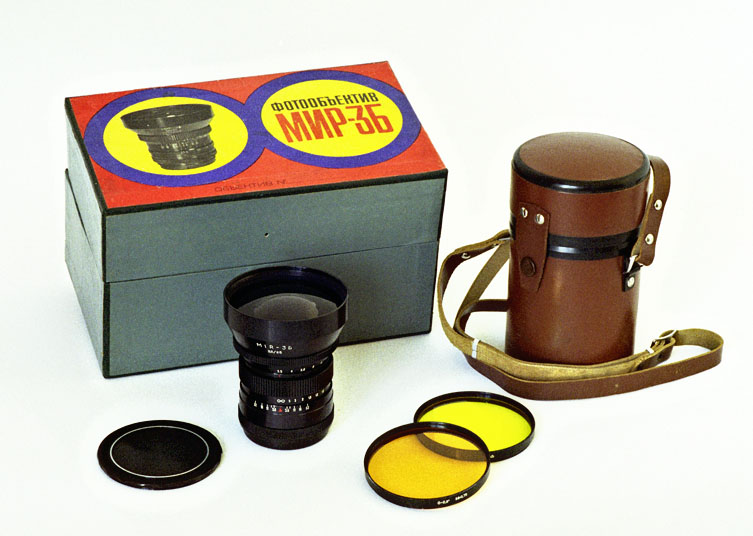
[C462_33.jpg]
|
| However, subsequently the Mir-38B
replaced the Mir-3B.
As can be seen from this picture (and the data above),
it was much smaller and lighter than the 3B.
Unfortunately, it seems as though in the intervening
years either disillusionment had set in, or at least the
pride in good workmanship had decreased, and the quality
control was so poor (if it existed at all!) that many
sub-standard lenses left the factory, not only for the
citizens of the Soviet Union of that time, but also for
the wider world.
In some countries, importers and distributors worked
hard to overcome these problems, checking, adjusting,
repairing or even rejecting items that did not come up
to professional standards. In the U.K., Technical
and Optical Equipment (London) Ltd did an
excellent job, thereby ensuring that Soviet lenses
achieved and maintained a high reputation in that
country.
However, with the collapse of the Soviet Union in the
early 1990s, there was an uncontrolled flooding of the
market with photographic equipment from the Former
Soviet Union, some of it brought to London in backpacks
by Poles who travelled between Warsaw and London by bus,
and sold it both privately and through some retail
photographic chains. The quality of such items was
often extremely poor.
It is therefore advisable to check such items carefully
before parting with money.
A description of my experiences with this particular
Mir-38B can be found here.
|
|
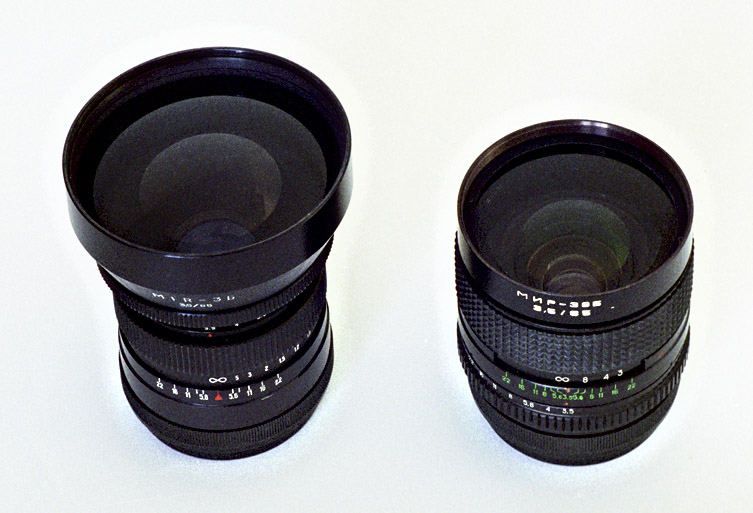
[C462_34.jpg]
The Mir-3B on the left, with the Mir-38B on the right
|
Tair-33
The manufacturers were extremely proud to have received the
“Grand Prix” award for this lens at the 1958 Universal Exhibition
at the Atomium in Brussels in 1958, and for decades referred to
this award in their publicity. The lens is good, but
extremely heavy, and it has no automatic control for the aperture
– admittedly a very new concept at that time. Instead, it
has a manual pre-set lever that enables the lens to be opened to
full aperture for composition and focussing, and then stopped down
to the pre-selected aperture without having to look at the
diaphragm settings. The lens also has a built-in retractable
lens hood. This is, however, extremely shallow and can’t
provide much shading. It is illustrated here next to a much
newer and slightly smaller version developed for use with the 35mm
Zenith Photosniper camera.
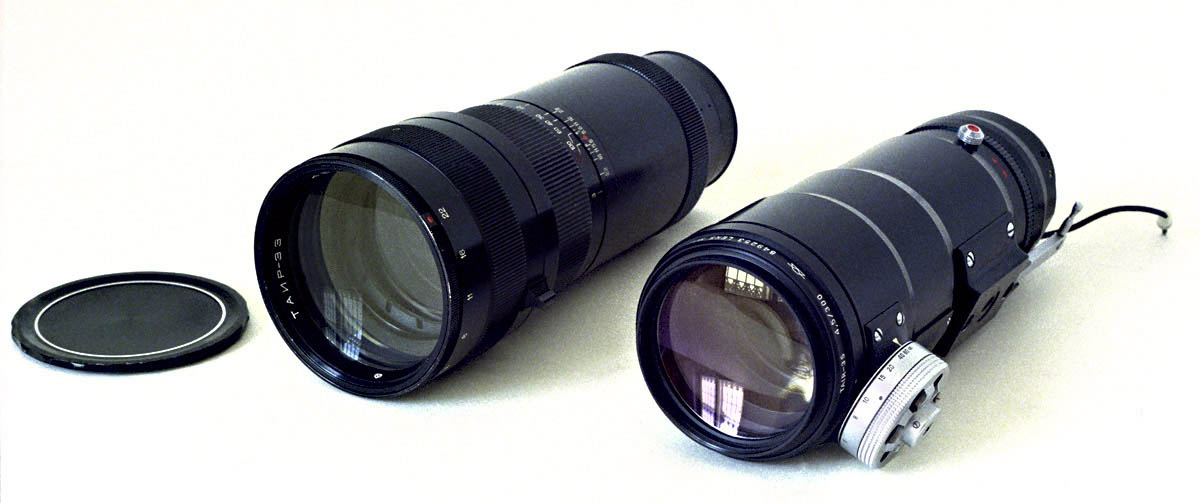
[C436-16] Tair-33 300mm lens in Kiev 60/Pentacon Six mount, with
the subsequent Tair-3S in M42 mount for the Photosniper 35mm
camera outfit.
Note the unusual focussing wheel on the Photosniper version, and
the cable that transfers the chosen aperture value
to the Zenith camera metering. The bar visible under this
lens at the back stops down the aperture when the shutter is
fired.
The Cyrillic (Russian-language) spelling of
the lens can be seen in the above photo. The lens was
also widely exported, and some of the exported lenses had
the name ring printed in Latin (or Roman) script (the
alphabet that is used for English and most West-European
languages, amongst others). On these lenses, the name
was transcribed as “TAYIR”. Naturally, the
manufacturers are entitled to transcribe the names of their
products as they wish, and this was clearly an attempt to
show that the original name is pronounced as two syllables
and not one. However, “TAIR” is an acceptable
transliteration of the Cyrillic and so is also sometimes
seen in descriptions of the lens. In fact, “TAIR” is
the Latin lettering that was chosen by the manufacturers for
the Photosniper version of this lens, as can be seen in the
above photograph!
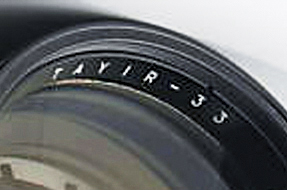
“TAYIR” lettering on lens |
|
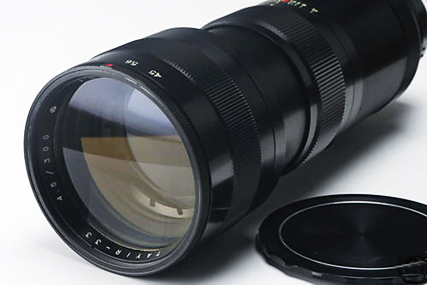 “TAIR” or “TAYIR” with Latin script
“TAIR” or “TAYIR” with Latin script
|
The Tair-33 can also be seen here
and some results of tests with the lens can be seen here.
In 2003 and again in 2008 a “Jupiter-6” lens was offered on
eBay. It was described as an extremely rare f/2.8 180mm lens
in Kiev 60 / Pentacon Six mount. It appeared to have no
aperture pin, to judge by the photographs on the auction. On
both occasions the illustrations showed an all “silver” metal
finish.
The two 500mm Rubinar mirror lenses (f/8 and f/5.6), which are
made by the LZOS factory just north of Moscow in Russia, not by
Arsenal at Kiev in Ukraine, and are designed for 35mm cameras,
have occasionally been modified to work with Medium Format cameras
that have the Pentacon Six mount. I have been told that the
results are very good, however, my experience with the samples
that I have tested has not confirmed this. See the results
of those tests, starting here.
Arsenal also produces a 2× converter and a 1.4× converter in the
Kiev 60 (Pentacon Six) mount.
This data is based on published sources. I do not have
examples of all of these lenses (!), and I have not measured or
weighed all those that I do have. Sources vary on some
details such as weights, and these differences may correspond to
different versions of a given lens.
Lens diagrams
Here are the lens diagrams published in the instruction manuals
of two of the lenses. Not to the same scale.
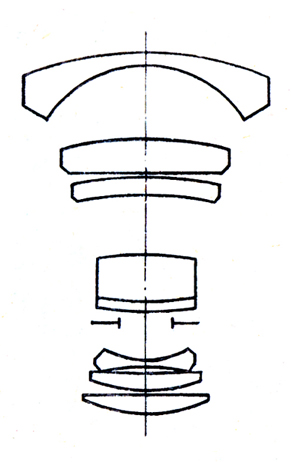
[mir26diag.jpg] Lens diagram for the Arsenal
Mir-26
wide-angle lens
|
|
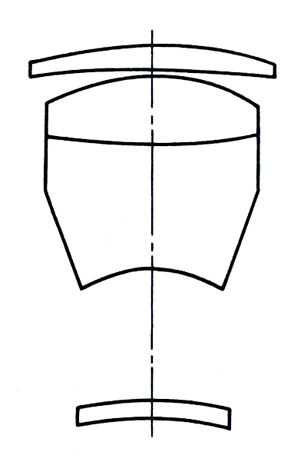
[jupdiag.jpg] Lens diagram for the 250mm
Jupiter-36 lens
|
To see more lens diagrams, click here
(30mm) and here (shift lenses).
Jupiter (Yupiter)
design change
As described here, there were
certain problems with the original design of the lens hood or
shade for the Jupiter 36 lens. This design detail was
obviously changed at some point – perhaps by someone who couldn’t
get his filter out of his shade!
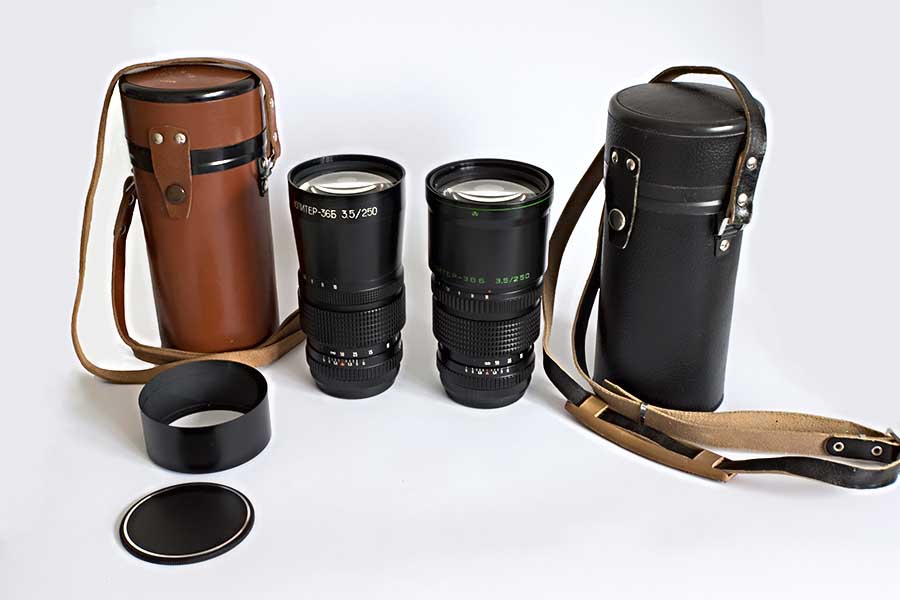
Two versions of the Jupiter 36B
[2yups.jpg] |
|
The lens illustrated on the left in this
image was manufactured in 1980. Its case, lens hood
(shade) and lens cap are placed to the left of it.
The Jupiter 36b on the right in this image was manufactured
in 1991. It has a permanently-mounted sliding lens
shade. Its case (now manufactured in black instead of
the earlier brown) is to its right. This lens, which
was not new when I bought it, came with a Vivitar lens cap
(not included in the pictures) -- no doubt an indication of
the more porous borders between the former communist
countries and the rest of the world in the aftermath of the
collapse of the communist system, the Berlin wall and some
of the other barriers to trade and travel.
Incidentally, even in 1991, the lens only had a single
coating, not multi-coating. However, another
improvement was included.
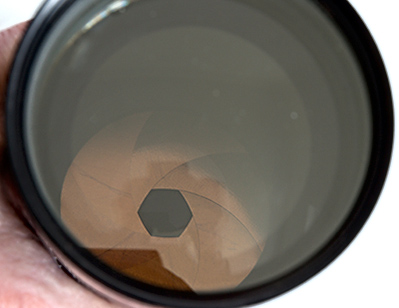 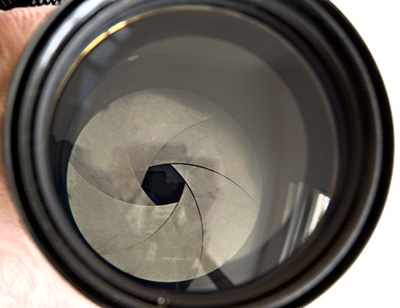
On the left, the 1980 Jupiter 36b, on
the right, the one from 1991.
The aperture blades in the older lens had a copper colour,
those in the newer lens were a neutral grey. It may
conceivably be that with the older lens, the colour of the
aperture blades might have changed the colour of the
image. Or it may just be that purchasers feared this,
and so the blades were changed to grey, as with the aperture
blades in lenses from other manufacturers. (Note that
such blades are rarely totally black.)
Note that the shadows in these two pictures are of the
photographer and the camera used to take the pictures of the
aperture blades.
|
Telear-4B
Here are some pictures of a Telear-4B
manufactured in 1984.
This particular example of the lens weighs 1130 g, is about
145mm long and (as can be seen from the depth-of-field
scales) has a minimum aperture of f/22.
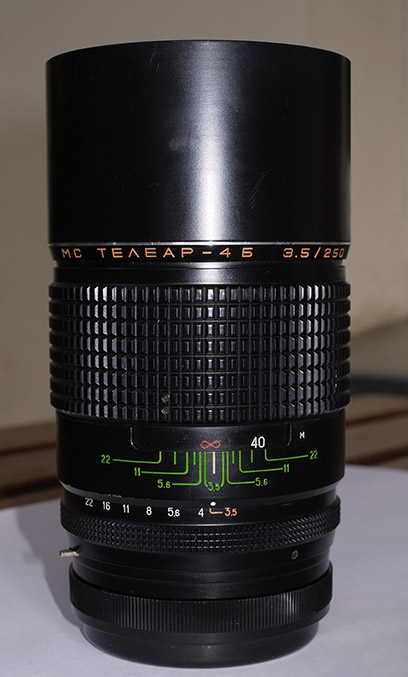 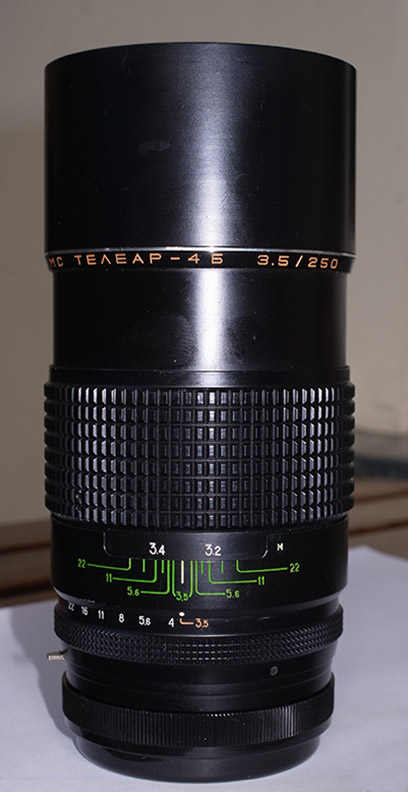
The same lens set on infinity focus (left, [tel4inf.jpg])
and at closest focus (right, [tel4minjpg]).
These pictures also show more clearly the maximum and
minimum apertures of the lens. The depth-of-field
preview lever can be seen near the bottom of each picture,
on the left of the lens.
I note that in these pictures the lens has an East German
Pentacon Six rear lens cap.
My thanks to Steffen for the information and the pictures!
|
|
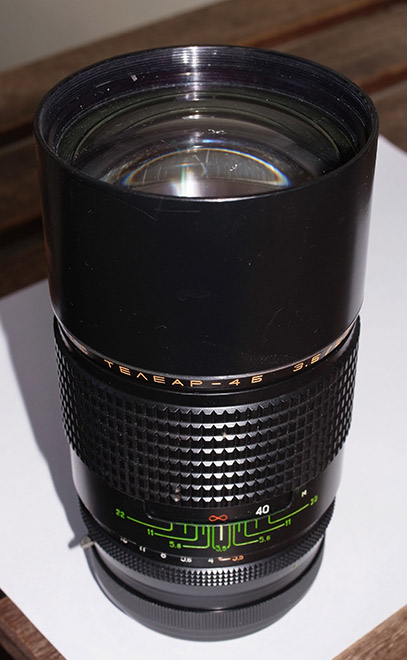
General view of the lens described here
[tel4top.jpg]
|
Lens mounts
It would appear that all of these lenses (possibly with the
exception of the 3M-3B mirror lens, the 500mm APO lens and the
Mir-69B 45mm lens) were produced in two different mounts:
the Pentacon Six mount used for the Kiev 60, and the Hasselblad
1600F/1000F mount used for the Salyut / Zenith 80 / Kiev 88.
When making a purchase, it is essential to get the lens in the right
mount, as they are mutually incompatible.
Until recently, manufacturers in the former Soviet Union
described the Pentacon Six mount as being: mount B (in Cyrillic –
the Russian alphabet – this a symbol like a b with a horizontal
bar extending right from the top of the upright: Б). They
described the Kiev 88 mount as being: mount V (B in Cyrillic – the
Russian alphabet). The differences are summarised in the
following table:

It is therefore necessary to take great care when ordering a lens
to make sure that it has the right mount for the camera.
The situation is made worse by the fact
that lenses were sometimes manufactured with the name
and mount written in Cyrillic script and
sometimes (presumably for export) with the name and
mount written in Latin script! Therefore,
looking at what is printed on the lens barrel or name
ring can also lead to confusion!! The only sure
way is to check (or see a clear photograph of) the lens
mount. The Pentacon Six mount has three lugs,
while the Kiev 88 mount has a coarse helical thread (a
sort of “screw mount”). Perhaps because of this
confusion, Arsenal now seem to be describing the
Pentacon Six mount as “Type C”, and labelling their
lenses accordingly. You can see a picture of an
example of this here.
|
To see pictures of the Pentacon Six and Salyut/Kiev 88 lens
mounts, go here.
An ideal system?
If you build up a system consisting of the 80mm Volna, the 120mm
Vega and the 250mm Telear, you will have a flexible, compact and
lightweight outfit that will cover most situations, with
all lenses taking filters of the same size!
Naturally, if you add a wide angle lens to the outfit, you will
need larger filters.
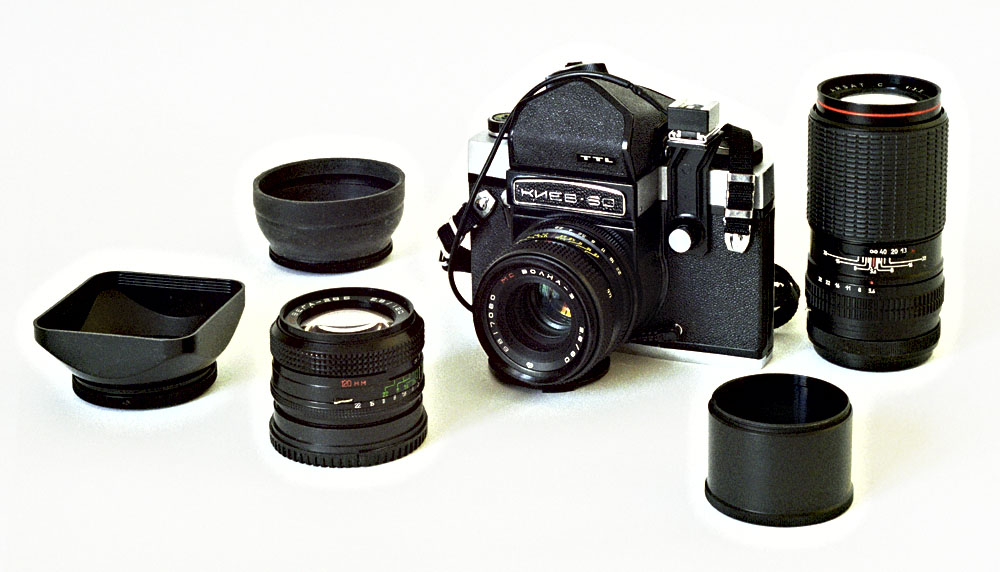
[C463_2.jpg]
This image of such an outfit includes a hot-shoe adapter in the
flash bracket, connected by a cable to the PC sync socket.
This permits use of a flash that does not have its own sync
cable.
Most of the Russian and Ukrainian lenses listed above are
illustrated and tested in the Lens Test section of this
website. To go to the lens test section, click here.
For further details of the lenses – number of elements and
grouping of elements, variations of the lenses, etc, I refer you
to Nathan Dayton's excellent website, www.commiecameras.com
To go on to the next section, click below.
Next section (Joseph Schneider lenses
for the Exakta 66)
To go back to the beginning of the Lens Data section, click below
and then choose the range of lenses that you want to read about.
Back to beginning of the Lens Data section
Home
© TRA May 2002, Latest revision: April 2024 (broken link
repaired)














